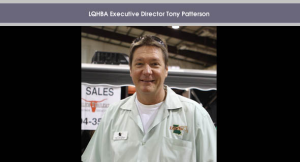Written by Barbara Newtown
Original Publish Date August 2015
 Tony Patterson came to the Quarter Horse world in a roundabout way. He was born in the very small town of Delhi in Northeast Louisiana and grew up in Ruston. His grandfather trained Thoroughbreds and raced in Louisiana in the winter and in Massachusetts in the summer. Tony enjoyed the racetrack scene—the horses, the people, and the business. In 1979 he went to work for Larry Robideaux, a Thoroughbred trainer in Shreveport. “I thought I wanted to train, but I saw quickly that to be a successful trainer I’d have to have the support of some very good owners. At 19 I lacked the self-confidence necessary, so I started thinking about going into the management side of the racetrack.”
Tony Patterson came to the Quarter Horse world in a roundabout way. He was born in the very small town of Delhi in Northeast Louisiana and grew up in Ruston. His grandfather trained Thoroughbreds and raced in Louisiana in the winter and in Massachusetts in the summer. Tony enjoyed the racetrack scene—the horses, the people, and the business. In 1979 he went to work for Larry Robideaux, a Thoroughbred trainer in Shreveport. “I thought I wanted to train, but I saw quickly that to be a successful trainer I’d have to have the support of some very good owners. At 19 I lacked the self-confidence necessary, so I started thinking about going into the management side of the racetrack.”
Going to college at Louisiana Tech in Ruston was an easy choice for Tony: his father Pat Patterson was the Tech baseball coach. The university started a racetrack management program a couple of years after Tony arrived. He took three or four classes from Dick Kinsey, who worked in the racing office at Louisiana Downs. Kinsey gave Tony advice about the racing business, and, says Tony, “before you know it, I took a couple of quarters off and went to work in the Louisiana Downs racing office.” After a few years, Tony moved on to the Fair Grounds in New Orleans. When a new track opened in Birmingham, Alabama, in 1987, Tony started working there, but he was hired away by Remington Park in Oklahoma City, a few months before that track opened in 1988. He went to work in the racing office and served as a placing judge and stakes coordinator.
Remington Park opened their inaugural meet with Thoroughbreds, and their first Quarter Horse meet ran in 1989. Tony ended up working as assistant racing secretary for Rob Werstler, racing secretary for the Quarter Horse meet. For the first time Tony got to know Quarter Horses and the people who race them. “The animals are magnificent,” he says. “The speed of the horses is so incredible. If you don’t get out of that gate quick, you usually aren’t going to finish anywhere near the money!”
Tony has a special appreciation for Quarter Horse people: he feels that they are down-to-earth and very hands-on. There isn’t the same tradition of old money that you find in Thoroughbred breeding and racing. “It seems sometimes that many Thoroughbred trainers have a groom for every three or four horses. I know that’s not the case with Quarter Horses. Those trainers have to take on a lot of the daily chores.”
Tony’s current position as Executive Director of the Louisiana Quarter Horse Breeders Association brings him into contact with an even greater variety of Quarter Horse supporters. He gets to come to work each day and interact with a “great group of members and a fantastic group of employees.” Although he is no longer involved in the day-to-day workings of a track, he feels deeply about the cuts that have been made in the racing industry. “It’s just not fair to the horsemen,” he says.
His work at the LQHBA makes a difference: the organization has run a million-dollar breeders futurity every year since 2012. Numbers of foals are rebounding from the dark days of 2009, 2010, and 2011. “The nominating and the sustaining payments help build the purses for our Futurities and Derbies,” Tony says. He points out that most of the purse money for the Kentucky Derby, for instance, comes from the racetrack purse account and corporate sponsorships. But the Quarter Horse breeders and owners contribute approximately 70% of the LQHBA breeders futurity purse. Their support of their own industry is admirable.
The LQHBA is the official registry of all racing Louisiana Bred Quarter Horses. They handle the paperwork that keeps the names and dollars straight…and they also promote the “product”—the Louisiana Bred Quarter Horse. Tony says that it is important to sign on new members, but it is also important to find more new buyers willing to spend more for Louisiana Bred yearlings. The futurity payments schedule really starts soon after the foal is born, then moves on to the yearling sale, and culminates with two-year-olds starting their racing careers. Futurities build excitement for the racing industry and continue to attract new owners and breeders to Louisiana.
Tony explains that the American Quarter Horse Association specifies that a horse cannot race before March 1st of its two-year-old year. However, the Mardi Gras Futurity, which used to run at the Fair Grounds and now takes place at Louisiana Downs, is “grandfathered in” to start trials in mid to late February. The Mardi Gras is the first Quarter Horse racing futurity of the year in the nation. All eyes are on Louisiana, and the publicity is priceless.
The Quarter Horse breeders awards program in Louisiana is designed to benefit the state’s economy. An out-of-state-owned mare must be domiciled in Louisiana from the time the mare is bred until the time her foal is born and accredited. The mare must be bred to a stallion that stands in Louisiana for the entire year. Once the foal is accredited, the owner can take the foal anywhere. (The LQHBA considers the breeder to be the owner of the mare when the foal was born.) Breeders awards kick in when the accredited horse runs first through fifth at a Louisiana track. Whether the race is for Louisiana-breds or is open, breeders get 25% of what the horse earns. For example, if the two-year-old you bred wins the million-dollar futurity at Evangeline Downs, the horse earns about $450,000, and your breeder’s check is over $110,000. “Last year the LQHBA paid out over $4.3 million in breeders awards,” Tony says. “We send out checks 30 to 60 days after the horse runs.”
The Quarter Horse racing industry in Louisiana is large. Perhaps 26 or 27 states have Quarter Horse racing, but Louisiana runs 20% of the total races nationwide for 20% of the total purse money nationwide. “That’s impressive,” says Tony. The trend is upwards: the 2012 yearling sale brought 10%-11% more than 2011; the 2013 sale brought 20% more than 2012; and the 2014 sale brought 25% more than 2013. Another sign of improving times is the LQHBA Derby program for three-year-old racehorses. Tony says, “When people say that horse racing is dying, maybe the crowds are different, because of simulcasting and other forms of gaming. But here in Louisiana we are on the right path, I’m sure.”





